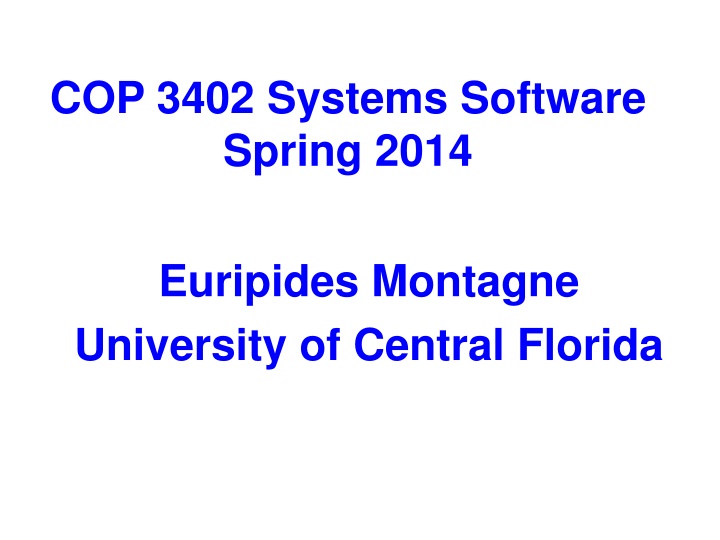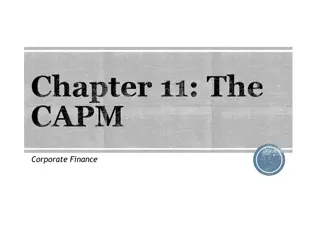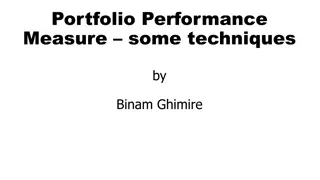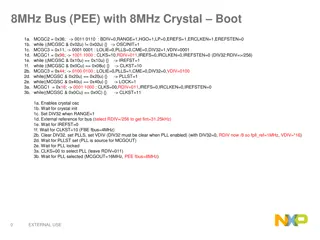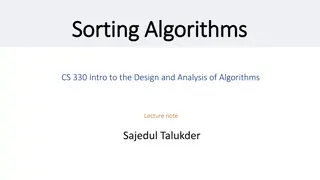Automatically Configuring Algorithms for Portfolio-Based Selection
This research explores the automated design of algorithms for portfolio-based selection, focusing on tools like SATzilla and Hydra to configure algorithms efficiently. By leveraging automatic configuration, the study aims to optimize algorithm selection processes, showcasing innovative strategies and practical applications in algorithm design. Through a systematic approach, the research aims to enhance algorithm performance and adaptability for various domains.
Download Presentation

Please find below an Image/Link to download the presentation.
The content on the website is provided AS IS for your information and personal use only. It may not be sold, licensed, or shared on other websites without obtaining consent from the author.If you encounter any issues during the download, it is possible that the publisher has removed the file from their server.
You are allowed to download the files provided on this website for personal or commercial use, subject to the condition that they are used lawfully. All files are the property of their respective owners.
The content on the website is provided AS IS for your information and personal use only. It may not be sold, licensed, or shared on other websites without obtaining consent from the author.
E N D
Presentation Transcript
COP 3402 Systems Software Spring 2014 Euripides Montagne University of Central Florida
COP 3402 Systems Software The processor as an instruction interpreter. Eur pides Montagne University of Central Florida 2
Outline 1. The structure of a tiny computer. 2. A program as an isolated system. 3. The instruction format. 4. Assembly language. Eur pides Montagne University of Central Florida 3
Von-Neumann Machine (VN) PC MAR MEMORY OP ADDRESS MDR A IR Decoder A L U Eur pides Montagne University of Central Florida 4
Instruction Cycle The Instruction Cycle, or Machine Cycle, in the Von-Neumann Machine (VN) is composed of 2 steps: 1. Fetch Cycle: Instruction is retrieved from memory. 2. Execution Cycle: Instruction is executed. A simple Hardware Description Language will be used in order to understand how instructions are executed in VN. Eur pides Montagne University of Central Florida 5
Definitions Program Counter (PC) is a register that holds the address of the next instruction to be executed. Memory Address Register (MAR) is a register used to store the address to a specific memory location in Main Storage so that data can be written to or read from that location. Main Storage (MEM) is used to store programs and data. Random Access Memory (RAM) is a implementation of MEM. Eur pides Montagne University of Central Florida 6
Definitions Memory Data Register (MDR) is a register used to store data that is being sent to or received from the MEM. The data that it stores can either be in the form of instructions or simple data such as an integer. Instruction Register (IR) is a register that stores the instruction to be executed by the processor. Eur pides Montagne University of Central Florida 7
Definition Arithmetic Logic Unit (ALU) is used to execute mathematical instructions such as ADD or SUB. DECODER is a circuit that decides which instruction the processor will execute. For example, It takes the instruction op-code from the IR as input and outputs a signal to the ALU to control the execution of the ADD instruction. Accumulator (A) is used to store data to be used as input to the ALU. Eur pides Montagne University of Central Florida 8
Fetch-Execute Cycle In the VN, the Instruction Cycle is defined by the following loop: Fetch Execute In order to fully explain the Fetch Cycle we need to study the details of the VN data flow. The data flow consists of 4 steps. Eur pides Montagne University of Central Florida 9
Data Movement 1 Given registers PC and MAR, the transfer of the contents of PC into MAR is indicated as: MAR PC PC MAR MEMORY OP ADDRESS MDR A Decoder A L U Eur pides Montagne University of Central Florida 10
Data Movement 2 To transfer information from a memory location to the register MDR, we use: PC MAR MEMORY(MEM) MEM[MAR] MDR MEM[MAR] OP ADDRESS MDR A The address of the memory location has been stored previously into the MAR register Decoder A L U Eur pides Montagne University of Central Florida 11
Data Movement 2 (Cont.) To transfer information from the MDR register to a memory location, we use: MEM [MAR] MDR *see previous slide for diagram The address of the memory location has been previously stored into the MAR Eur pides Montagne University of Central Florida 12
Data Movement 3 Transferring the contents of MDR into IR is indicated as: IR MDR PC MAR MEMORY OP ADDRESS MDR A Decoder A L U Eur pides Montagne University of Central Florida 13
Instruction Register Properties The Instruction Register (IR) has two fields: Operation (OP) and the ADDRESS. These fields can be accessed using the selector operator . Eur pides Montagne University of Central Florida 14
Data Movement 4 The Operation portion of the field is accessed as IR.OP The operation field of the IR register is sent out to the DECODER using: DECODER IR.OP DECODER: If the value of IR.OP==00, then the decoder can be set to execute the fetch cycle again. Eur pides Montagne University of Central Florida 15
Data Movement 4 Cont. DECODER IR.OP PC MAR MEMORY OP ADDRESS MDR A Decoder A L U Eur pides Montagne University of Central Florida 16
Instruction Cycle The Instruction Cycle has 2 components. Fetch Cycle which retrieves the instruction from memory. Execution Cycle which carries out the execution of the instruction retrieved. Eur pides Montagne University of Central Florida 17
00 Fetch Cycle 1. Copy contents of PC into MAR 2. Load content of memory location into MDR 3. Copy value stored in MDR to IR 4. Increment PC Register 1.MAR PC 2.MDR MEM[MAR] 3.IR MDR 4.PC PC+1 5.DECODER IR.OP Eur pides Montagne University of Central Florida 18
Execution: 01 LOAD 1. Copy the IR address value field into MAR 2. Load the content of a memory location into MDR 3. Copy content of MDR into A register 4. Set Decoder to execute Fetch Cycle 1. MAR IR.ADDR 2. MDR MEM[MAR] 3. A MDR 4. DECODER 00 Eur pides Montagne University of Central Florida 19
Execution: 02 ADD 1. Copy the IR address value field into MAR 2. Load content of memory location to MDR 3. Add contents of MDR and A register and store result into A 4. Set Decoder to execute Fetch cycle 1. MAR IR.ADDR 2. MDR MEM[MAR] 3. A A + MDR 4. DECODER 00 Eur pides Montagne University of Central Florida 20
Execution: 03 STORE 1. Copy the IR address value field into MAR 2. Copy A register contents into MDR 3. Copy content of MDR into a memory location 4. Set Decoder to execute fetch cycle 1. MAR IR.ADDR 2. MDR A 3. MEM[MAR] MDR 4. DECODER 00 Eur pides Montagne University of Central Florida 21
Execution: 07 HALT 1. Program ends normally 1. STOP Eur pides Montagne University of Central Florida 22
Instruction Set Architecture (ISA) 01 Load MAR MDR A MDR DECODER 03 Store MAR IR.Address MDR A MEM[MAR] DECODER 07 Halt 00 Fetch (hidden instruction) MAR PC MDR MEM[MAR] IR MDR PC PC+1 DECODER IR.OP 02 Add MAR IR.Address MDR MEM[MAR] A A + MDR DECODER 00 IR.Address MEM[MAR] 00 MDR 00 Eur pides Montagne University of Central Florida 23
One Address Architecture (instruction format) The instruction format of this one-address architecture is: OP ADDRESS LOAD 0000 0000 0010 Eur pides Montagne University of Central Florida 24
Instruction Set Architecture 01 - LOAD <X> Loads the contents of memory location X into the A (A stands for Accumulator). 02 - ADD <X> The data value stored at address X is added to the A and the result is stored back in the A. 03 - STORE <X> Store the contents of the A into memory location X . 04 - SUB <X> Subtracts the value located at address X from the A and stored the result back in the A. Eur pides Montagne University of Central Florida 25
Instruction Set Architecture 05 - IN <Device #> A value from the input device is transferred into the AC. 06 - OUT <Device #> Print out the contents of the AC in the output device. Device # 5 7 9 Device Keyboard Printer Screen For instance you can write: 003 IN <5> 23 where 23 is the value you are typing in. Eur pides Montagne University of Central Florida 26
Instruction Set Architecture 07 - Halt The machine stops execution of the program. (Return to the O.S) 08 - JMP <X> Causes an unconditional branch to address X . PC X 09 - SKIPZ If the contents of Accumulator = 0 then PC=PC+1 ( the next instruction is skipped). (If the output of the ALU equals zero, the Z flag is set to 1. In this machine we test the flag and if Z = 1 the next instruction is skiped (pc= pc + 1) Eur pides Montagne University of Central Florida 27
If the output of the ALU equals zero, the Z flag is set to 1 PC MAR MEMORY Z =Condition Code OP ADDRESS MDR A 0 Decoder A = 0 A L U Z Eur pides Montagne University of Central Florida 28
Instruction Set Architecture For this tiny assembly language, we are using only one condition code (CC) Z = 0 . Condition codes indicate the result of the most recent arithmetic operation Two more flags (CC) can be incorporated to test negative and positives values: G = 1 Positive value Z = 1 Zero L = 1 Negative value Eur pides Montagne University of Central Florida 29
Program State Word (condition codes - CC) The PSW is a register in the CPU that provides the OS with information on the status of the running program CC Interrupt Flags MASK Mode PC OV MP PI TI I/O SVC G Z L To be defined later In addition to the Z flag, we can incorporate two more flags: 1) G meaning greater than zero 2) L meaning less than zero Eur pides Montagne University of Central Florida 30
ISA Instruction descriptions opcode mnemonic meaning 0001 0010 0011 0100 0101 0110 0111 1000 1001 1010 1011 LOAD <x> ADD <x> STORE <x> SUB <x> IN <Device_#> OUT <Device_#> HALT JMP <x> SKIPZ SKIPG SKIPL A Mem[x] A A + Mem[x] Mem[x] A A A Mem[x] A read from Device A output to Device Stop PC x If Z = 1 Skip next instruction If G = 1 Skip next instruction If L = 1 Skip next instruction Eur pides Montagne University of Central Florida 31
Assembly language Programming examples Assign a memory location to each variable: C X + Y; <000> <001> <002> If it is necessary to use temporary memory locations, assign labels (names) to them. Eur pides Montagne University of Central Florida 32
Assembly language Programming examples Memory 000 1245 001 1755 002 0000 003 Load <000> 004 Add <001> 005 Store <002> 006 Halt Memory 000 1245 001 1755 002 3000 003 Load <000> 004 Add <001> 005 Store <002> 006 Halt After execution Eur pides Montagne University of Central Florida 33
One Address Architecture The instruction format of this one-address architecture consists of 16 bits: 4 bits to represent instructions and 12 bits for addresses : OP ADDRESS 0001 0000 0001 0001 Eur pides Montagne University of Central Florida 34
Assembler: translate symbolic code to executable code (binary) Assembly Language 003 Load <000> 004 Add <001> 005 Store <002> 006 Halt 01 02 03 STORE 04 SUB 05 IN LOAD ADD 06 07 08 09 OUT HALT JMP SKIPZ In binary 0001 0000 0000 0000 0010 0000 0000 0001 0011 0000000000010 0111 0000000000000 003 004 005 006 Assembler Eur pides Montagne University of Central Florida 35
Assembler Directives The next step to improve our assembly language is the incorporation of pseudo-ops (assembler directives) to invoke a special service from the assembler (pseudo-operations do not generate code) .begin tell the assembler where the program starts .data to reserve a memory location. Labels are symbolic names used to identify memory locations. .end tells the assembler where the program ends. Eur pides Montagne University of Central Florida 36
Assembler Directives This is an example of the usage of assembler directives .begin Assembly language instructions halt (return to OS) .data (to reserve a memory location) .end ( tells the assembler where the program ends) note: the directive .end can be used to indicate where the program starts (for example: .end <insert label here> Eur pides Montagne University of Central Florida 37
Assembly language Programming examples Label start a b TWO in store in store load sub add out halt .data .data .end opcode address .begin x005 a x005 b a TWO b x009 Text section (code) 0 0 .data start Data section 2 Eur pides Montagne University of Central Florida 38
LOAD/STORE ARCHITECTURE A load/store architecture has a register file in the CPU and it uses three instruction formats. Therefore, its assembly language is different to the one of the accumulator machine. ADDRESS OP JMP <address> Ri OP ADDRESS Load R3, <address> OP R i R j R k Add R3, R2, R1
Load/Store Architecture PC INPUT/OUT MAR MEMORY R0 R1 R2 R3 OP MDR Decoder A L U + Eur pides Montagne University of Central Florida 40
Multiplying two numbers Label start here a b ONE result .begin in store in store load load load load add sub skipz jmp store load out halt .data .data .data .end opcode address Label start here a b ONE result .begin in store in store load add store load sub store skipz jmp load out halt .data .data .data .end opcode address x005 R0, a x005 R0, b R2, result R3, a R0, b R1, ONE R2, R2, R3 R0, R0, R1 x005 a x005 b result a result b ONE b here R2, result R0, result x009 here result x009 0 0 1 .data start 0 0 1 .data start 0 0 One address Architecture (six memory access inside the loop) Load/Store architecture (no memory access inside the loop) Eur pides Montagne University of Central Florida 41
Next time will talk about virtual machines Lecture 2
